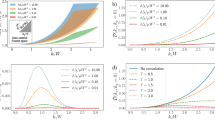Abstract
In this study the scattered-filed computation using the combined method of ray tracing and diffraction (CMRD) is revisited but with an extension to the backscattering computation. The concept of the equivalent phase object is considered as the key part in the developed CMRD method, and is analyzed mathematically with accurately derived expressions for its amplitude and phase function. A formulated CMRD method for the backscattering computation is developed in this work, which is then used in the forward modeling and numerical computations for ultra-wideband pulse propagation and backscattering from a perfectly conducting circular cylinder. The numerical simulation indicates that reasonable and good agreements can be achieved for comparisons between our CMRD method and exact eigenfunction expansion approach. It is expected that the theoretical model and method of backscattering calculation using CMRD can be applied to the image processing and target identification with measurements of backward-scattered electromagnetic and acoustic waves.








Similar content being viewed by others
References
Ruppin, R. (1990). Electromagnetic scattering from finite dielectric cylinders. Journal of Physics D: Applied Physics, 23, 757–763.
Houdzoumis, V. A., Wu, T. T., & Myers, J. M. (1996). Backscattering of an electromagnetic missile by a metal cylinder of degree higher than two. Journal of Physics, 80, 15–24.
Zhu, D., & Bjorno, L. (2000). A three-dimensional, two-way, parabolic equation model for acoustic backscattering in a cylindrical coordinate system. Journal of the Acoustical Society of America, 108(3), 889–898.
Jech, J. M., Horne, J. K., Chu, D., Demer, D. A., Francis, D. T. I., Gorska, N., et al. (2015). Comparisons among ten models of acoustic backscattering used in aquatic ecosystem research. Journal of the Acoustical Society of America, 138(6), 3742–3764.
Shang, Y., Shen, Z., & Feng, K. (2016). Enhancement of backscattering by a conducting cylinder coated with gradient metasurface. Journal of Applied Physics, 120, 045109.
Bowman, J. J., Senior, T. B. A., & Uslenghi, P. L. E. (1969). Electromagnetic and acoustic scattering by simple shapes. Amsterdam: North-Holland Publishing Company.
Mitri, F. G. (2010). Acoustic backscattering enhancements resulting from the interaction of an obliquely incident plane wave with an infinite cylinder. Ultrasonics, 50, 675–682.
La Follett, J. R., Williams, K. L., & Marston, P. L. (2011). Boundary effects on backscattering by a solid aluminum cylinder: Experiment and finite element model comparisons (L). Journal of the Acoustical Society of America, 130(2), 669–672.
Chen, B., & Stamnes, J. J. (1998). Scattering by simple and nonsimple shapes by the combined method of ray tracing and diffraction: Application to circular cylinders. Applied Optics, 37(11), 1999–2010.
Stamnes, J. J. (1986). Waves in focal regions. Bristol: Hilger.
Stamnes, J. J., Spjelkavik, B., & Pedersen, H. M. (1983). Evaluation of diffraction integrals using local phase and amplitude approximations. Optica Acta, 30, 207–222.
Potter, L. C., & Moses, R. L. (1997). Attributed scattering centers for SAR ATR. IEEE Transactions on Image Processing, 6(1), 79–91.
Qiu, R. C. (2004). A generalized time domain multipath channel and its application in ultra-wideband (UWB) wireless optimal receiver design—Part II: Physics-based system analysis. IEEE Transactions on Wireless Communications, 3(6), 2312–2324.
Zhao, Y., Hao, Y., & Parini, C. (2007). FDTD characterization of UWB indoor radio channel including frequency dependent antenna directivities. IEEE Antennas and Wireless Propagation Letters, 6(11), 191–194.
Christodoulou, C., Railton, C. J., Klemm, M., Gibbins, D., & Craddock, I. J. (2012). Analysis of a UWB emispherical antenna array in FDTD with a time domain Huygens method. IEEE Transactions on Antennas and Propagation, 60(11), 5251–5258.
Acknowledgements
The first author would thank Professor J. J. Stamnes for his initial comments on CMRD, and Dr. X. Huang for her earlier related discussions and calculations. This study was supported by the National Natural Science Foundation of China (Grant No. 11547035) and the Shandong Province Higher Educational Science and Technology Program (Grant No. J18KZ012).
Author information
Authors and Affiliations
Corresponding author
Additional information
Publisher's Note
Springer Nature remains neutral with regard to jurisdictional claims in published maps and institutional affiliations.
Rights and permissions
About this article
Cite this article
Chen, B., Chen, C. & Ma, H. The Combined Method of Ray Tracing and Diffraction and Its Application to Ultra-wideband Pulse Propagation. Wireless Pers Commun 112, 395–409 (2020). https://doi.org/10.1007/s11277-020-07033-7
Published:
Issue Date:
DOI: https://doi.org/10.1007/s11277-020-07033-7




